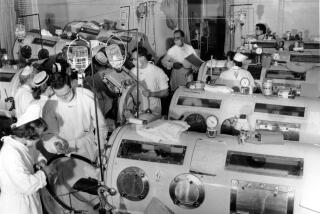Student filmmakers find themselves drawn into the vaccine/autism fray
- Share via
reporting from CARLSBAD, Calif. — Every school day, students at Carlsbad High tune in their classroom televisions to a news show produced by its award-winning broadcast journalism program.
Airing from a well-appointed studio on campus, the report covers topics ranging from final exams to nearby wildfires, delivered by a teenage staff that typically goofs around until the cameras roll and professionalism descends.
Carlsbad High has come to expect a lot from CHSTV, a “signature program,” according to schools Supt. Suzette Lovely.
But no one expected the kind of attention that has lately muzzled one of its most acclaimed works — a short documentary produced by an extracurricular offshoot of the program.
The movie, “Invisible Threat,” bills itself as a report on “the science of disease and the risks facing a society that is under-vaccinated.”
As the students and their advisors prepared to debut it, they found themselves cast as foot soldiers in a long-running immunization war between a small group of activists who argue that vaccines cause autism and the vast majority of physicians and scientists who say they don’t.
The anti-vaccine groups — whose work has contributed to the recent decline in immunization rates in some parts of the country, medical authorities believe — charged that the Carlsbad students had been duped by deceitful advisors who had been paid off by the pharmaceutical companies that make vaccines.
The criticism surfaced before the movie was finished and wore on for more than a year.
It delayed the launch of the movie for months and became heated enough in May that Carlsbad’s parent-teacher association canceled an on-campus screening for fear that grumbling activists would show up, as they had when the film was shown at Cal State San Marcos.
“We didn’t want to put the kids who worked on this into a position where people could get on campus and harass them,” said Kym Szalkiewicz, president of the parent-teacher group.
The students of CHSTVfilms, as the extracurricular program is called, said they were blindsided by the reaction.
“We’re an extracurricular film club,” said Mark Huckaby, the graduating senior who narrated the film. “It’s just not cool.”
They deny being pawns of anyone.
The idea for “Invisible Threat” came from a group of silver-haired Rotary Club volunteers who had been working for 20 years to promote immunization in San Diego County.
The area’s historically high vaccination rate was starting to slip. According to the California Department of Public Health, the percentage of new kindergartners in San Diego County who seek exemptions from immunizations has increased from 1.09% 15 years ago to 4.49% last school year.
Health advocates were alarmed to see diseases like measles and whooping cough, long reined in by immunization programs, emerge anew. In neighboring Orange County, 22 people came down with measles in the first five months of 2014 — part of a frightening nationwide surge for the virus, which was officially eliminated in the U.S. in 2000.
Amnon Ben Yehuda and Larry Scott, who worked with the Rotarians’ local “Don’t Wait ... Vaccinate” program and were familiar with CHSTVfilm’s previous work on the Holocaust and hunger, figured the students might be able to do a good job getting the message across.
But the young people and their advisors thought the Rotary proposal — to make a 20-minute educational film explaining how the immune system and immunization work — seemed boring, they said. And they bristled when the Rotarians told them how the movie should be made, added Bradley Streicher, one of the students who worked on it.
“We said, if we do this, we have to do this on our terms,” he said. “We wanted to explore this from both sides.”
In the end, the club officials agreed — “We took a flier,” said Ben Yehuda — and started raising $60,000 to cover production and buy equipment that would also be used by CHSTV.
Then the student team dived in, said Lisa Posard, a parent advisor who served as the film’s producer and whose then-student daughter wrote the film’s script.
They read studies. They talked to medical experts who praised vaccines. And they interviewed parents who distrusted vaccines, as well as a local osteopath who treats autistic children.
Some of the students initially believed vaccines and autism were linked, they said, but changed their minds as they researched.
“It was all social controversy. There was no science controversy,” said Allison DeGour, who will be a senior this fall.
Complaints began to arise when a local newspaper reported that the students were tackling “the issue of immunizations.”
A blogger who saw the article contended that the movie, still a work in progress, was sure to be “propaganda.” That led to a flurry of frightening phone calls and Internet comments directed at CHSTV, Posard said.
Posard said she hadn’t realized that vaccines were such a controversial subject. She and CHSTV teacher Douglas Green wanted to shut down production, she added. But the students, angered by what they saw as bullying, insisted on completing the film.
The final version of “Invisible Threat,” completed in spring 2013 but shown only to select audiences, took a strong pro-vaccine position.
Critics, who said they hadn’t been allowed to see the movie, leaped back into action about a year later, when the film was set to be screened on Capitol Hill.
Focus Autism and AutismOne organizations complained about the movie’s Rotary Club backing and about the involvement of Dr. Paul Offit, a University of Pennsylvania pediatrician and immunization proponent. They argued that “Invisible Threat” was “scripted with industry talking points” and that the movie seemed to be the work of adults operating under false pretenses, not students.
Indeed, one expert interviewed in the film — Dr. Shawn Centers, a San Diego osteopath who treats many autistic patients who forgo vaccination — told The Times he was misled about the subject matter. He noted that the scenes in his office were not shot by a student but by Green, a former PBS Television teacher advisor and current president of the national Student Television Network.
“When they came to interview us, I wasn’t aware at all that this was a movie about vaccines,” Centers said. “They told us it was a movie about autism.”
Green, who is credited as the director of “Invisible Threat,” disputed that account. “I would never encourage students to deceive anybody,” he said.
Green acknowledged that he and Posard were there with film student Streicher on the day Centers was interviewed. Green also confirmed that he operated the camera, noting that teaching high school filmmakers involves being hands-on at times.
But in all, he said, 16 students had a hand in shooting, writing, editing and appearing in “Invisible Threat.”
Streicher, who this fall will be a sophomore in USC’s Annenberg School of Communications’ broadcast journalism program, called the controversy “disheartening.”
“We really took pride in the work we did as students,” he said. “It’s sad to see that people would call it into question.”
The Rotarians didn’t get to see the film until it was done, but they were thrilled. “I cried,” Ben Yehuda said.
Public health experts liked it too.
“They did a good job with the scientific material,” said Dr. Melinda Wharton, director of the U.S. Centers for Disease Control and Prevention’s immunization services division.
“It is a wonderful movie,” agreed Dr. Trish Perl, an infectious-disease specialist at Johns Hopkins Medicine. “I would have loved it to be shown in my children’s school.”
Because of the hubbub, most parents and students at Carlsbad High still haven’t seen “Invisible Threat.”
In June, Szalkiewicz said her parent organization was planning a screening for the fall but that she was seeking a more secure off-campus venue.
“I wish we could put it on the Internet,” Huckaby, the movie’s narrator, said around the same time. “Educating young people about this is key.”
After students and community members kept urging a skittish Posard to simply post the film, she finally announced this month that the movie would go on the Web on Aug. 1, in conjunction with National Immunization Awareness Month.
Follow @LATErynbrown for more news about healthcare.
More to Read
Sign up for Essential California
The most important California stories and recommendations in your inbox every morning.
You may occasionally receive promotional content from the Los Angeles Times.











